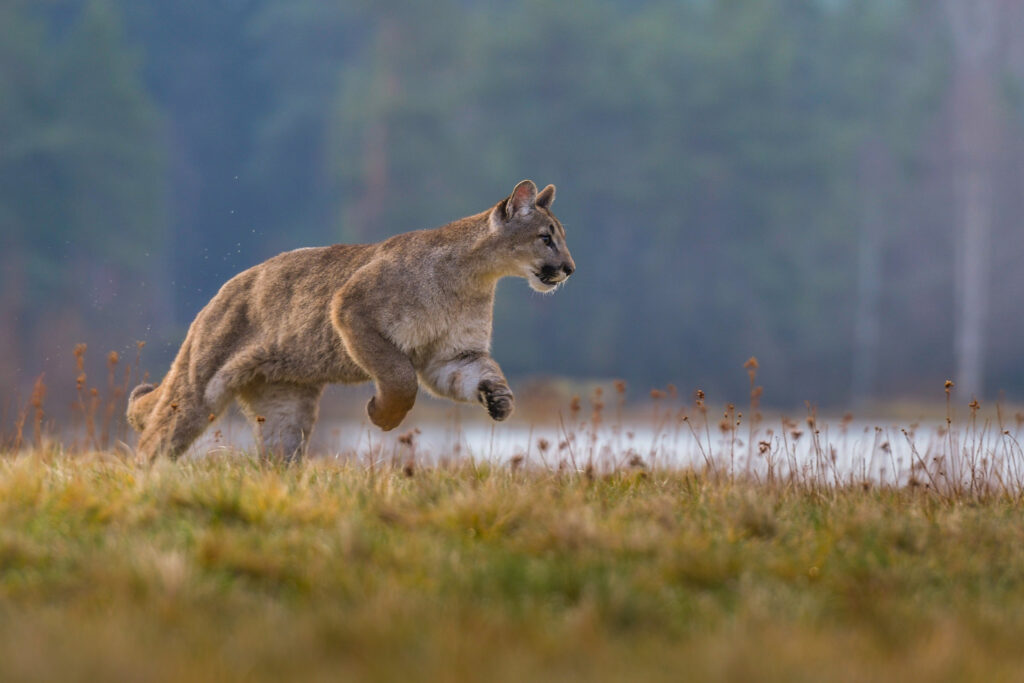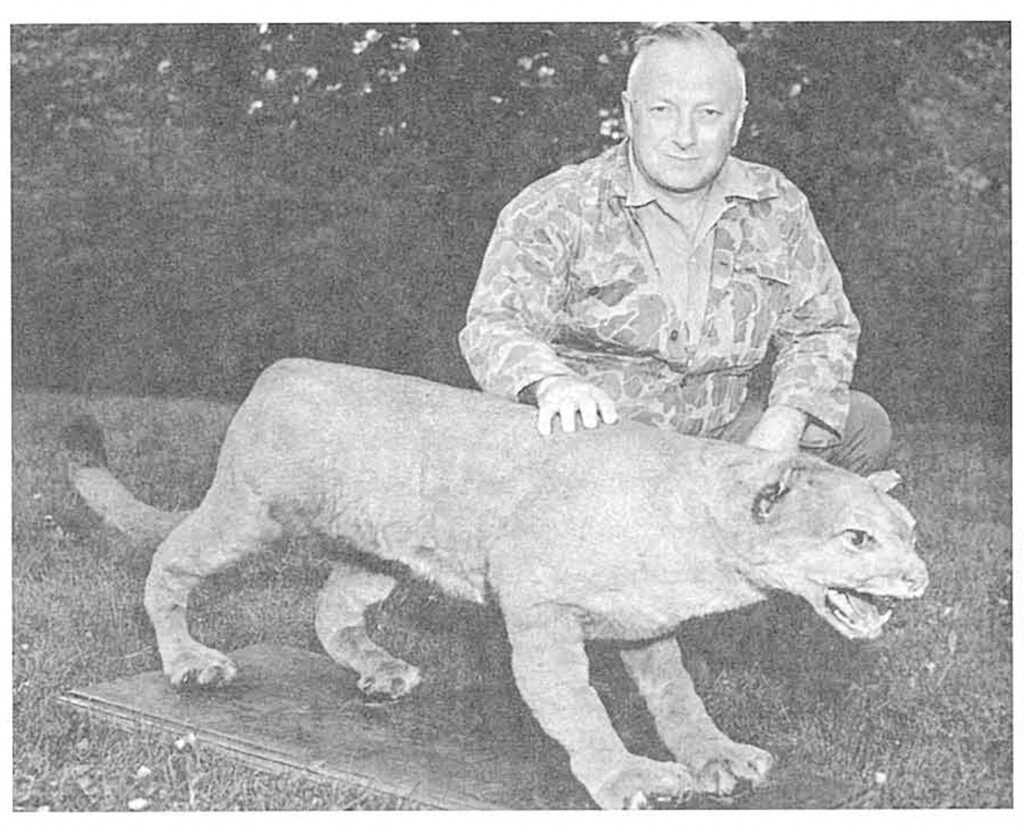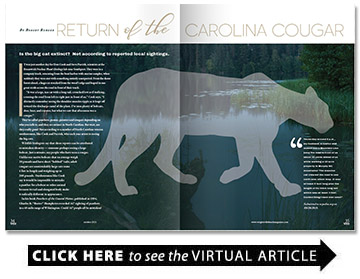Return of the Carolina Cougar
Is the big cat extinct? Not according to reported local sightings.
BY Robert Rehder

It was just another day for Don Cook and Steve Parrish, scientists at the Brunswick Nuclear Plant’s biology lab near Southport. They were in a company truck, returning from the boat harbor with marine samples, when suddenly they were met with something entirely unexpected. From the dense forest ahead, a huge cat streaked from the wood’s edge and leaped in one great stride across the road in front of their truck.
“It was a large, tan cat with a long tail, crouched low as if stalking, crossing the road from left to right just in front of us,” Cook says. “I distinctly remember seeing the shoulder muscles ripple as it leapt off toward the discharge canal of the plant. I’ve seen plenty of bobcats, deer, bear, and coyotes, but what we saw that afternoon was a cougar.”
They’re called panthers, pumas, painters and cougars depending on who you talk to, and they are extinct in North Carolina. But wait, are they really gone? Not according to a number of North Carolina veteran outdoorsmen, like Cook and Parrish, who each year attest to seeing the big cats.
Wildlife biologists say that these reports can be attributed to mistaken identity — someone perhaps seeing a large bobcat. Just a minute, say people who have seen a cougar. Unlike our native bobcats that on average weigh 20 pounds and have short “bobbed” tails, adult cougars are unmistakably large cats some 6 feet in length and weighing up to 200 pounds. Outdoorsmen like Cook say it would be impossible to mistake a panther for a bobcat or other animal because its tail and elongated body make it radically different in appearance.
In his book Panthers of the Coastal Plains, published in 1994, Charles R. “Buster” Humphries recorded 167 sighting of panthers in a 40-mile range of Wilmington. Could 167 people all be mistaken?
Still, biologists say sightings of the Eastern cougar, known locally as the Carolina Cougar, have not been officially documented in more than 100 years. As a result, the U.S. Fish and Wildlife Service declared it extinct. And so, the native big cat that once roamed North Carolina is no more, right? Well, not exactly.
It is true that while reports of large cats across North Carolina are common each year, little physical evidence exists to confirm most of the accounts.
At 6:20 am this morning, I was stopped in the road to adjust my camera setting on my iPhone, when I glanced up, so astonished to see a pale golden cougar, long tail curled at the end, slink low and quickly cross the road in front of me, vanishing into the tall marsh grass landscape. I live on Cape Hatteras Island and this was in the National Park in Buxton. I sat a long while hoping to see some sign of it but it was gone, no tracks could I find. Obviously I didn’t get a photo, it happened so quickly!”
Submitted to ncpedia.org on 06/09/2021.
That all changed some years ago when Dr. Ben Smith Sr., noted Wilmington dentist, oral surgeon, and veteran outdoorsman, not only saw a cougar on his farm in a remote area of Leland near the Cape Fear River, but then made an impression of its pugmark (in this case its rear paw print) to prove what he saw was real. For the first time there was credible, reliable, physical evidence that at least one big cat was back.
How do skeptical biologists explain away the pugmark? They can’t. What they say is there can be no survivors of the original Carolina Cougar, but they do at least buy into the idea that big cats could roam into North Carolina from a neighboring state.
Since September 2015, the Tennessee Wildlife Resources Agency has multiple sightings of cougars listed on its website. Each is vetted and confirmed with a trail camera photo.

In Virginia, there were so many cougar sightings that citizens started a research site, Cougar Quest Virginia, to document sightings with observations, research and photos. The published findings led them to believe that cougars live in and traverse though Virginia and nearby states.
In a recent report, South Carolina resident and historian Dr. Tom Horton, while driving along U.S. 341 an hour before sunset near the intersection of Winterhaven Road one mile east of Kershaw, saw what he described as a large cat crossing the road. The head was round and large, the color was mottled brown, and the tail was long and very thick. A panther no doubt.
Horton’s encounter is far from rare. From Blacksburg to McClellanville, sightings of panthers are so common that the Internet has become a bulletin board for South Carolina panther reports, some with accompanying photos.
It’s 130 miles from McClellanville to the Leland site where Smith cast the pugmark – much of that route through the notoriously impenetrable Green Swamp, beloved of all things wild. A cougar could make that trip before lunch.
As a result of so many sightings, and in view of recent research, wildlife biologists now agree that it is possible through what they call genetic exchange that a new strain of big cats unrelated to the extinct Carolina Cougar species could enter the state from somewhere else. Sightings confirm the theory, and each has three compelling similarities: large-bodied cat, tawny-brown color, and a long tail. Those are not descriptions that fit a bobcat, wild pig or bear.
It certainly makes sense that if our neighboring states have panthers, then surely we could have them here. But if we do, why hasn’t one been photographed, trapped, killed on a North Carolina highway, or shot by a hunter?
There are good reasons. For one thing, cougars are endangered and federally protected so if a hunter were to shoot one and be apprehended there could be a $10,000 fine and other penalties including jail time. No reasonable hunter would take that chance.
Cougars are stealthy, people-shy, solitary, cautious hunters rarely seen by humans even where they are known to exist, like in Florida’s Everglades Swamp where they flourish. Do we have similar swamps?
Home to every creeping, crawling, death-dealing creature imaginable, three of the darkest, most treacherous, most formidable swamps in all the South lie along the North Carolina coastal plain — the Great Dismal Swamp, Angola Bay, and the Green Swamp — each similar to the Everglades and perfect panther lairs. The phenomenal resurgence in those places of whitetail deer, a cougar’s favorite prey, makes the habitat ideal.
The Angola, in Pender and Duplin Counties, encompasses 34,000 acres, most of it virtually inaccessible and some of it so desolate toward the interior that it has not been seen by man in a century. All signs of civilization literally disappear in such places, much to a panther’s preference.
Kit Taylor, Charles Wells and Tripp Pippin, all veteran deer and bear hunters, report seeing a large cat on the edge of the Angola while checking roads during a winter ice storm.
“It was late in the deer season, and we were checking downed trees that may have blocked our access roads,” Taylor says. “Suddenly, this big cat with a long tail leaped out of the forest into the middle of the road, stretched out, and in one leap, crossed the road and into the adjacent forest wall. All three of us yelled ‘cougar’ at the same time. Cougars may well be living undisturbed in the Angola, where deer, their favorite quarry are plentiful. It’s such a secretive, secluded place that most hunters and woodsmen may never see a cougar … but we did! We’ve seen bears, bobcats and coyotes there for many years, and we don’t mistake them for a cougar. What we saw was a cougar, plain and simple, probably 100 pounds, tawny brown with a long tail.”
Yesterday around 5 p.m., my husband, a realtor and myself had a Mountain Lion jump the road in front of us about 30 yards ahead of us while walking a 19 acre property in Murphy NC mountains! The massive cat cleared the road in one swift near silent leap. It was at least 5 foot long plus the length of its thick long tail which was at least 3 feet. Coolest thing I have ever seen!”
Submitted to ncpedia.org on 09/28/2019.
Russ Lane, another native North Carolinian, veteran woodsman and hunter, tells of seeing a cougar while deer hunting in the Goshen Swamp in Duplin County.
“I was hunting from a deer stand in the Goshen, and a panther came out at 125 yards and stayed in my scope for several minutes, hunting with its nose on the ground,” he says. “It was brown, maybe four feet long, and looked to weigh at least 125 pounds. I clearly saw a dark tip on its tail. Later that day I talked to members of a hunt club in the area who use hounds to flush game from impassable swamp areas. They said they have seen panthers both in the Goshen and the Angola. You can believe it or not, but they’re here with us.”
Well suited for swamp life, the cougar is an excellent hunter in all weather conditions. An expert swimmer and skilled climber, it has agility, perseverance, a rather grim set of fangs fore and aft, and they can sprint up to 50 mph! Cougars hunt by sight and scent and prefer deer, but will eat mice, game birds, fish, slugs, grasshoppers, skunks, raccoons, foxes, goats and horses. Interspersed with deep guttural growls and sharp hisses, they emit a terrifying scream much like the shriek of our native barn owl.
Do the regularity of sightings, the documented pugmarks, and the personal encounters confirm the cougar’s return to Eastern North Carolina? Biologists say the panther is gone for good, but a growing group of convincing locals say otherwise, and so the debate continues.
With all the evidence, it’s easy to believe the cougar has once again come to call in our Southern haunts. After all, it seems the big cats are quite literally at home in the deep forests, bays and swamps of our coastal plain, which contain all of their necessities and so few of man’s.
So next time you’ve escaped to a lovely rural area for a bit of peaceful relaxation, and from the nearby woods you happen to hear the chilling scream of a barn owl, relax. It’s probably just a panther.


About 3 years ago I heard what I thought were bobcat screams from my back porch in Highlands NC.
The next day I found a cat track in the mud by the creek on my neighbor’s property that was about 3″ in diameter. Bobcat tracks are about 1.5″ diameter.
Last week I was in my front yard shortly after dark and I heard a very loud roar. I don’t know what word to use besides roar.
It sounded like a very large cat. Definitely not a house or domesticated cat from the pitch of the sound. I don’t want to say it was like a lions roar but somewhere in the middle.
I heard the roar and all the deer ran away and then I could hear rummaging in the woods. All of this was very loud which makes me say it was a big cat. Wondering if the NC panther could be back on the eastern coast.
I really wish I had the words to describe the roar. Let’s just say it definitely got my immediate attention.
I swear I saw one run through my backyard last year and I’m in Currituck cty
One morning in 1999 I was driving to work along Highway 55 about six miles west of New Bern, NC when a cougar crossed the road approximately 50 yards ahead of me. It was a sunny, cloudless morning and the cougar was moving at a fast trot so I was able to easily identify what it was. It was much larger than a bobcat and had the classic long tail and tawny color. Also, it’s gait was distinctively feline. A number of friends who are avid hunters have told me that they have occasionally sighted cougars in that general area over the years.
Driving home this morning, I saw one cross the road in front of me in Pamlico County, NC.. Unmistakable. Big cat, long tail, cougar. I even told my husband that I wish I had a dash cam just for things like this!
Just saw one in Asheville. At Dusk he leaped in one bound across most of a two-lane road then one bound up onto the embankment on the other side. Once there realizing my car was near he totally flattened himself for a few seconds which I imagine they do to disguise themselves. Then up and with a leap cleared the embankment and disappeared into the woods This all so quickly that I didn’t get a second full-body look at him.
He had a tail almost as long as his body. He was, I think, at least two or three feet tall in my headlights Now in terms of your possible disbelief in what I am describing, I am an artist and have the heightened visual acuity and color recognition needed for portrait and landscape painting. As I said it was dusk, not quite dark, and lower light colors were still visible in my headlights, such as the brown leaves on the embankment. This cat was BLACK . . . BLACK when he crossed the road and definitely black when he flattened himself on the embankment as I could clearly see his outline against the brown leaves. I have a black house cat. He’s not fat but when he flattens himself on the floor I’m always surprised that he seems a little fleshy on his sides. This panther/cougar had the same fleshiness on his sides for the few moments he was flattened.
Wow, what a privilege to have seen him, or her. I had been noticing that the fences on pasturing in that area heve be upgraded from one or mabe two strands to several more strands of electrified fence.
This is crazy that I found this article ,I’ve just began hunting 3 years ago so I’m fairly new to this. Last year I was here on my property in blackville south Carolina walking around the areas close to the marshland. I stopped because I saw a group of deer running and I layed down and looked through my rifle scope at them . They weren’t worried about me because they were running from something frantically but quietly so I looked behind them and I see 2 large cats almost the same colors as the deer. I stared at them for as long as I could even to see they had no tags anywhere. Aa soon as I felt they were far enough I jumped uo and ran to my truck. I’ve told this story to everyone who’ll listen . But I know what I saw.
I swear I saw 1 today in ACE Basin. Not to far from you.
Out of the thousands of trail cameras…how come there are no clear photos of them?
forgot to leave my phone no. 804 690 6868.
Have the resident of Hatteras Island that reported the Mountain Lion in Buxton. I live in Buxton and would like him to know of my sighting.